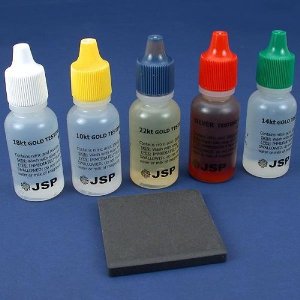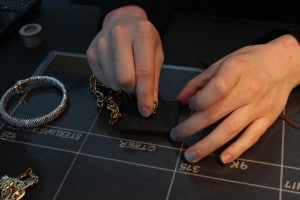One of the questions you are probably asking yourself when you’re thinking of selling old gold jewelry is “how do you test it?” All precious-metal buyers will go through similar methods to determine the purity of your jewelry, coins, bullion, etc. When it comes to testing gold, it’s not hard science, just useful equipment and a good eye.
1. Magnet Test
After inspecting an item for signs of wear or for stamps and markings, the magnet test can help pull out real gold items or fake/plated items. Solid gold as well as silver and platinum are non-magnetic. If your jewelry is magnetic it either means it’s made with magnetic metals (iron, nickel, cobalt) or it is gold plated or filled. At our stores, we use a rare earth magnet which is powerful enough to pick up on anything magnetic. Note: Even if an item does not stick to a magnet, does not mean it’s real. Some gold-plated or gold-filled items can be non-magnetic; it depends on what kind of metal is used underneath the surface. This is just a preliminary stage of testing before moving onto more certain testing methods.
Pros:
-
-
- Easy way to weed out obviously plated items
-
Cons:
-
-
- Cannot 100% confirm if an item is real or fake, and should be accompanied by other tests
-
2. Testing Acids
 An Acid Test or a Scratch Test is what you’ll see each and every time you come to our store to have gold tested. It is not a 100% accurate test, but very close. The test is straight forward and the overall goal is to figure out the gold purity.
An Acid Test or a Scratch Test is what you’ll see each and every time you come to our store to have gold tested. It is not a 100% accurate test, but very close. The test is straight forward and the overall goal is to figure out the gold purity.
The first step is to scratch a sample of the metal onto a testing stone like the one below. One thing to look for is the color of the scratch mark. If you have yellow gold, the mark should be yellow as well. If you see the mark change color as you are scratching, like gray or copper-red, then the item is most-likely plated and the underlying metals are showing through.
The next step is to apply a drop of your testing acid and watch it for several seconds for the reaction. Typically acids come in 10k, 14k, 18k and 22k acid strengths. The testing acids are a combination of nitric and muriatric acid and are meant to dissolve the scratch mark.
For example, if you have an item that is stamped “10k”, the 10k acid should NOT dissolve the scratch mark. In other words, if the scratch mark holds up to the testing acid karat, then it is at least that purity.
Let’s say you have an item and there isn’t a karat stamp on it. Make your scratch mark and apply the 10k acid. If it holds up, move onto the 14k, and so on, until you begin to see the mark definitively dissolve. And let’s say the mark didn’t dissolve at 14k but did at 18k. That means the piece is at least 14k, but less than 18k. To determine where it falls between 14k and 18k, it depends on how quickly and substantially the mark faded. If it faded instantly, then it’s more on the 14k side. If 50% of the scratch mark fades after ten seconds, then it’s more in the middle at 16k.
Pros:
-
-
- Great way to test unstamped pieces and small, fine items
- Effective way to narrow down the purity
- Fairly easy and affordable way to test gold
- Can point out fake and plated items
-
Cons:
-
-
- The higher the purity you go, the trickier it becomes to narrow down the purity
- The acid tests the surface layer of an item, thus it doesn’t test the overall purity of an item and heavily plated items can past this test
-
3. Density Test
The density test is a great compliment to the acid test because it can determine the exact percentage of the gold purity, and it can indicate if an item is plated or filled. Watch the video below for a quick demonstration of a density machine testing a gold bar.
First, the demonstrator locked in the weight of the bar outside of water, and then the weight of it under water. The number that is calculated (19.3) is the specific gravity, which is what we look for in the density test. Specific gravity is the ratio of the density of a substance to the density of a reference substance. In the case in the video, 19.3 is the ratio of pure (100%) gold to water (the reference substance) which is 1. In other words, solid gold has a density ratio 19.3:1 to the density of water. In the video, the demonstrator changed the mode to “karat” in which “24” came up (24k=99.99%).
The drawback to this test is that it requires the item to be completely solid. Hallow parts where air is trapped or stones and gems will skew the calculation because their densities will be factored in. This is also why the density test is great for determining plated or filled items, because the density of the underlying metal will be calculated, resulting in a low density.
Pros:
-
-
- Much more accurate than the acid test and can calculate purity down to the exact percentage
- Because it calculates density, it measures the overall purity, not just the surface like the acid test
-
Cons:
-
-
- The item must be solid (not hallow or gemstones) to get an accurate result
- Small and fine items are harder to test
-
4. X-Ray Machine
The X-Ray Test or XRF Spectrometers like the one advertised in the video above is much more high tech and advantageous. The main benefit is breaking down the different alloys and percentages. It works by measuring fluorescence of the item after being exposed to a small amount of x-ray radiation. To put it simply, the radiation will cause the elements (gold and silver) in the item to emit energy (or fluoresce), and the machine picks that up and figures out how much energy of each element was exposed.
This machine is not always necessary when you come in to have jewelry tested. This is often used as a last resort or to test questionable or unusual pieces that are not testing well in either the acid test or the density machine.
Pros:
-
-
- Can read out the different alloys and their percentages of an item
- The most accurate test
-
Cons:
-
-
- XRF Spectrometers only test the surface level
- Machines are very expensive
-
After reading this, it should be no surprise when you come in to have your items tested. Of course, each piece is different and we test accordingly. The next question you’re probably asking is “what’s it worth?” In that case, check out our tables of gold, silver, and platinum rates and prices – What Is My Gold Worth – or call one of our convenient locations. If you have diamonds, and would like to know a little more on how their values are assessed, check out our other blog post Grading Diamonds: What You Need to Know.

